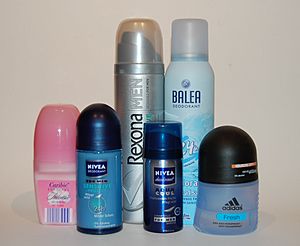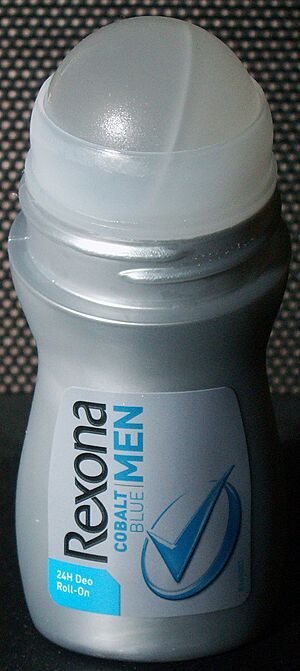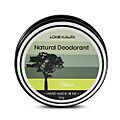Deodorant facts for kids
A deodorant is a product you put on your body to stop or hide bad smells. These smells are usually caused by tiny living things called bacteria that break down your sweat, especially in places like your armpits or feet.
A special type of deodorant is called an antiperspirant. Antiperspirants actually stop you from sweating. They do this by blocking your sweat glands. People use antiperspirants on different parts of their body where sweating might be annoying or even unsafe. For example, too much sweat can make you uncomfortable, blur your vision, or make things slippery to hold. Other deodorants let you sweat but stop the bacteria from making the sweat smell bad. Human sweat only smells when bacteria start to break it down.
In the United States, the government agency that looks after food and drugs (the Food and Drug Administration) sees most deodorants as cosmetics (like makeup). But they see antiperspirants as over-the-counter drugs, which means you can buy them without a doctor's note.
The very first commercial deodorant, called Mum, was created and patented in the late 1800s. An inventor named Edna Murphey in Philadelphia, Pennsylvania, came up with it. The modern way antiperspirants are made was patented by Jules Montenier in 1941. This new type was first used in a spray deodorant called "Stopette," which was very popular in the early 1950s.
Some people have worried that using deodorants with aluminium might be linked to breast cancer. However, studies have not found any clear proof of this link.
Contents
How Deodorants Started
In 1888, the first modern deodorant, Mum, was invented by Edna Murphey in Philadelphia, Pennsylvania. A larger company bought her small business in 1931. Later, in the 1940s, a woman named Helen Barnett Diserens came up with a new way to put deodorant on your underarm, using an idea from the new ball-point pen. In 1952, her company started selling this product as Ban Roll-On. This product was taken off the market in the U.S. for a short time but is now back. In the UK, it's sold as Mum Solid and Mum Pump Spray.
The first antiperspirant you could buy was called Everdry, and it came out in 1903. The modern way antiperspirants are made was patented by Jules Montenier in 1941. His invention helped solve the problem of aluminum chemicals irritating the skin. His new formula was first used in "Stopette" deodorant spray. This spray became very famous because it was the first and long-time sponsor of a popular TV game show called What's My Line?
Between 1942 and 1957, the market for deodorants grew hugely. At first, deodorants were mostly sold to women. But by 1957, about half of all men were also using them.
In the early 1960s, the first aerosol (spray can) antiperspirant was Gillette's Right Guard. Spray deodorants were popular because you didn't have to touch your underarm. By the late 1960s, half of all antiperspirants sold in the U.S. were sprays. However, in the late 1970s, their popularity dropped. First, the U.S. Food and Drug Administration stopped the use of a key ingredient in sprays because they worried about people breathing it in over time. Second, the U.S. Environmental Protection Agency limited the use of certain gases (called chlorofluorocarbons or CFCs) in sprays because these gases were harming the ozone layer, which protects Earth. As spray deodorants became less popular, stick antiperspirants became more common.
What's Inside Deodorants?
Deodorants and antiperspirants use different ingredients to work. Here are some common ones:
- Aluminum salts (like aluminum chlorohydrate) are used in almost all everyday antiperspirants. The aluminum reacts inside your sweat glands to create a tiny plug that stops sweat from coming out.
- Alum (often called "rock alum" or "natural deodorant") is a natural crystal. It has been used for a long time because it stops bacteria from growing. All alum products contain aluminum, but in a different form than in antiperspirants.
- Bactericidal products like triclosan kill bacteria on your skin.
- Alcohols can help dry your skin and also kill bacteria.
- Methenamine is a strong antiperspirant used for very heavy sweating.
- Acidifiers help keep your skin slightly acidic. This natural acidity, called the acid mantle, helps reduce bacteria. Soaps can sometimes make your skin less acidic, but these deodorants help keep it balanced.
- Masking scents are strong, pleasant smells that cover up body odor. These often come from plants or are made in labs.
- Activated charcoal and similar products can soak up sweat and bad smells. Even though charcoal is usually black, the activated charcoal in deodorants can be very light in color.
- Less often, products like milk of magnesia (a liquid form of magnesium hydroxide) are used. Some milk of magnesia products have tiny, safe amounts of sodium hypochlorite (which is like bleach). This ingredient is a strong germ-killer and might help explain why it works as a deodorant. (Remember, bleach in higher amounts is dangerous and poisonous!)
Different Kinds of Deodorants
Deodorants and antiperspirants come in many forms, and what's most popular can be different in various countries. In Europe, spray deodorants are common, along with creams and roll-ons. In North America, solid sticks or gel forms are used the most.
Are Deodorants Safe?
Sometimes, after using a deodorant with zirconium, some people might get an allergic reaction under their arm. Antiperspirants with propylene glycol can sometimes irritate the skin and make it more sensitive to other ingredients. Deodorant crystals made from potassium alum were found to be a mild skin irritant. If you have sensitive skin, you can find unscented deodorants. Some studies have shown that frequent use of deodorants might be linked to higher levels of a man-made scent called galaxolide in the blood.
See also
- Air freshener
- Aluminum chlorohydrate
- Perfume
 In Spanish: Desodorante para niños
In Spanish: Desodorante para niños
Images for kids






